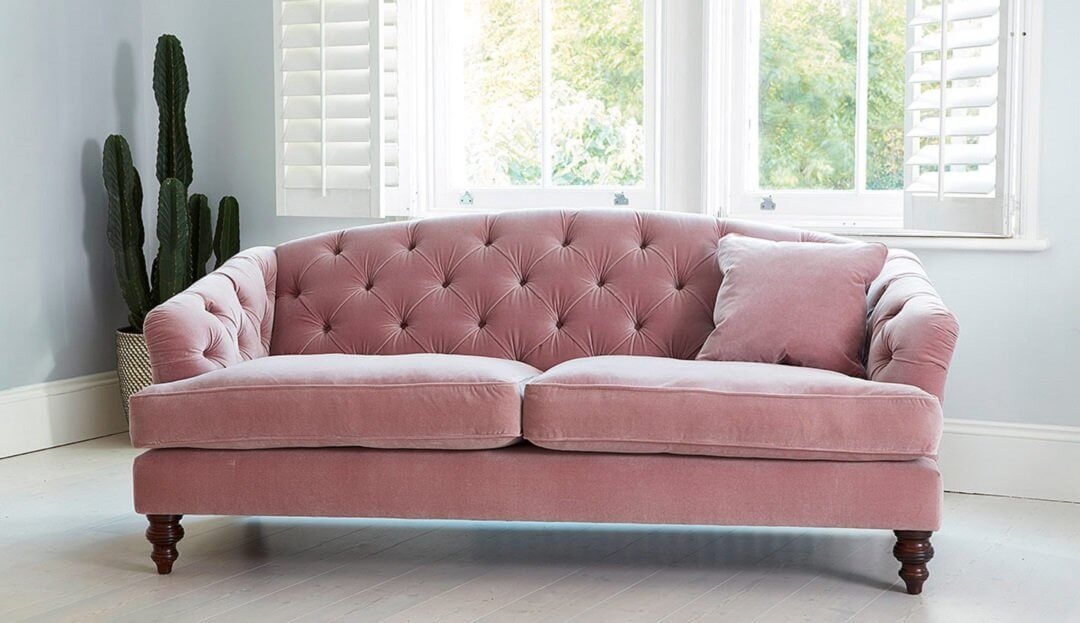How to Take Care of Your Velvet Sofa
Velvet fabric sofas look and feel fantastic; soft and warm to sit on, and rich and vibrant to look at. They do need careful looking after, however, if you want them to stay looking their best for years to come.
What is velvet, and why does it need special care?
To begin with, it helps to understand what velvet is. It’s manufactured, unusually, with two pieces of fabric facing each other and threads woven between them. When these are cut apart, the result is two sheets of fabric with a short, soft pile. It is this pile that gives velvet its unique appearance as well as its soft and inviting feel. However, it can also be challenging to keep clean. One problem is that the pile can trap dust and dirt, meaning that a simple wipe or brush may not always be enough to remove all of the particles. Another issue is with spills, where the individual fibres that make up the pile will ‘wick’ any liquid spilt on it, quickly soaking it in and making it difficult to wipe off or absorb with a sponge or cloth.

Varese 100% Cotton Velvet
To add to those challenges is the fact that the nap can easily be crushed or compressed, either by regular use or by overly aggressive cleaning methods. That means not only should you be careful to maintain the nap and restore it if it loses its sheen, but you also need to be cautious about how you clean your velvet sofa to ensure you don’t make the situation worse.

Modena Crushed Velvet
Different types of velvet and how to clean them
Velvet comes in a number of different varieties, and what kind of velvet you have has an impact on how you should clean it. To begin with, it’s worth bearing in mind that velvet can be made of a number of different fabrics, including wool, cotton, linen, silk and artificial fabrics or blends.
Cotton or polyester velvets can generally be cleaned at home, with care and a suitable upholstery cleaner. It’s always best to test the cleaner on a hidden area of the fabric and leave it for 24 hours to make sure it doesn’t discolour or damage your velvet. Assuming everything is ok, apply the cleaner with a sponge, making sure you don’t crush or squash the nap of the fabric. Then just vacuum or brush the fabric. Note that cotton velvet can kink while being cleaned so use care and try not to wet the fabric any more than you have to.
 Varese 100% Cotton Velvet
Varese 100% Cotton Velvet
Unfortunately, acetate, silk or rayon velvets are generally best left to professionals as home cleaning can damage them, so it’s much better to use a specialist cleaner.
Everyday care of velvet furniture
The most important way to maintain your velvet furniture is to clean it regularly but gently; a little brushing and regular careful vacuuming with a vacuum cleaner that has an upholstery attachment will go a long way to avoiding other problems.
It’s also well worth moving, turning and shaking velvet sofa cushions to avoid them developing long-term wrinkles that can then become hard to remove.
However, despite your best efforts, there are a couple of common issues with velvet furniture that are likely to arise. These, fortunately, can easily be taken care of at home, and knowing how to deal with these will help you to keep your sofa always looking its best.

Ashdown Chaise Sofa in Vintage Velvet
Pressure marks on velvet: Because the appearance of velvet relies on the individual fibres of the pile standing on end, when these are squashed through someone sitting on the fabric for a long period, marks can appear where it has been sat on. These can’t be prevented and are an entirely normal part of owning velvet furniture. Most will eventually recover by themselves, but to get rid of them more quickly you can apply steam and gently brush in the direction of the pile to lift and restore it.

Vintage Velvet
Loss of velvet sheen: Over time, velvet can lose its sheen altogether as the pile naturally collapses a little. Sometimes, simply brushing the velvet against the pile can be enough to restore its appearance. Otherwise, if your sofa has removable covers, you can try gently steaming the reverse side of the fabric.
Dealing with spills and stains
Spilling liquid on a velvet sofa can seem like a nightmare, as it quickly soaks in and seems impossible to remove. However, by gently blotting with a cloth, without rubbing or applying too much pressure, much of the liquid can be removed. Any remaining can be dried with a hairdryer used from enough of a distance to avoid damaging the fabric with heat. Then just brush the fabric to restore the pile and prevent it from matting.

Helena Sofa in Stain Resistant Velvet
Unfortunately, any serious spills or those that cause long-term stains may require professional cleaning by an expert who knows how to clean velvet properly and maintain it in the best possible condition.
Keeping a velvet sofa looking pristine can seem like a frustrating task, but a small amount of attention regularly applied goes a long way, and the end result is always worth it, as they look fantastic and will age gracefully and elegantly over the years to come.


